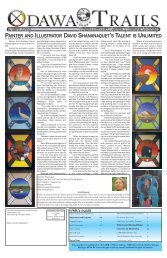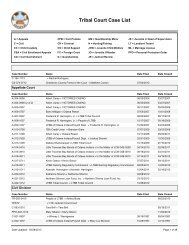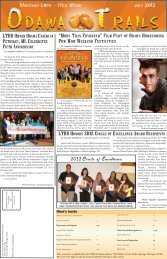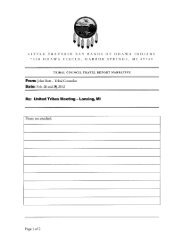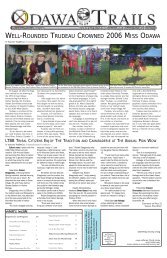LTBB Master Land Use Plan - Little Traverse Bay Bands of Odawa ...
LTBB Master Land Use Plan - Little Traverse Bay Bands of Odawa ...
LTBB Master Land Use Plan - Little Traverse Bay Bands of Odawa ...
Create successful ePaper yourself
Turn your PDF publications into a flip-book with our unique Google optimized e-Paper software.
.<br />
Population Projections<br />
Carrying this reasoning one step further, we must look into the future. Population projections<br />
can be developed using many methods, however in rural areas such as Northern Michigan the<br />
simplest techniques will most likely produce the most accurate results. In addition, the choice <strong>of</strong><br />
method (in this case a straight-line progression) reflects that used by the State <strong>of</strong> Michigan for most<br />
purposes.<br />
As can be seen from Table 9, both Charlevoix and Emmet Counties can reasonably expect to see<br />
population increases near 10,000 persons over the next 25 to 30 years. Graph 7 illustrates the<br />
problem with this simple approach. In effect, the ratio <strong>of</strong> population distribution between the<br />
various units <strong>of</strong> government is permanently fixed, and so only total County population is accurately<br />
projected. Changes in population amongst the MCD’s are not accurately portrayed.<br />
Perhaps a better way to look at population distribution within a County is shown in Table 10.<br />
This method takes a 30-year historical snapshot <strong>of</strong> population in a jurisdiction, and essentially<br />
continues the trend that averages out, for that jurisdiction. Thus, it is more likely to show patterns <strong>of</strong><br />
change, i.e. population moving from one township to another. Graph 8 and Table 11 both display<br />
the result.<br />
HOUSING CHARACTERISTICS<br />
Housing in the area covered by this plan varies enormously in availability, cost, and quality<br />
throughout the Reservation area. The use <strong>of</strong> land for housing and shelter represents a significant<br />
proportion <strong>of</strong> all land uses in most areas. Generally, changes in statistical information related to<br />
housing and shelter mirror important changes in the character <strong>of</strong> an area. Therefore, the change in<br />
the number <strong>of</strong> housing units, percentage <strong>of</strong> owner-occupied units, or increases in building permit<br />
activity over time are all important factors that shape planning decisions.<br />
Dwelling Unit Percent Change 1990 – 2000<br />
Graph 9 is entitled “1855 <strong>LTBB</strong> Reservation <strong>Land</strong>s – Dwelling Unit % Change 1990-2000” and<br />
depicts the growth or decline in the actual number <strong>of</strong> dwelling units, by area municipality, between<br />
the 1990 Census and the 2000 Census. A dwelling unit can be a single-family house, a condominium<br />
unit, an apartment, or any other structure that can be permanently lived in. The source <strong>of</strong> this graph<br />
is shown as Table 12.<br />
This graph gives us a clear indication <strong>of</strong> which areas are experiencing the most residential growth<br />
pressure. Most importantly, however, when used in conjunction with other data on land use it gives<br />
us a good way to predict where residential development opportunities might exist in the near future.<br />
This can be seen further in Maps 7 through 10, which show the data evolving over time.<br />
Housing Characteristics Tabulation<br />
Related directly to the population demographics <strong>of</strong> an area are the characteristics <strong>of</strong> the housing<br />
base. The use <strong>of</strong> land for housing and shelter is a significant portion <strong>of</strong> all land uses in most areas.<br />
Generally, changes in statistical information related to housing and shelter mirror important changes<br />
in the character <strong>of</strong> an area. Officials and citizens alike cite the need for adequate housing, and for<br />
housing that matches the demographics <strong>of</strong> the area.<br />
15



